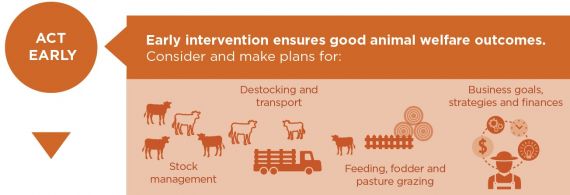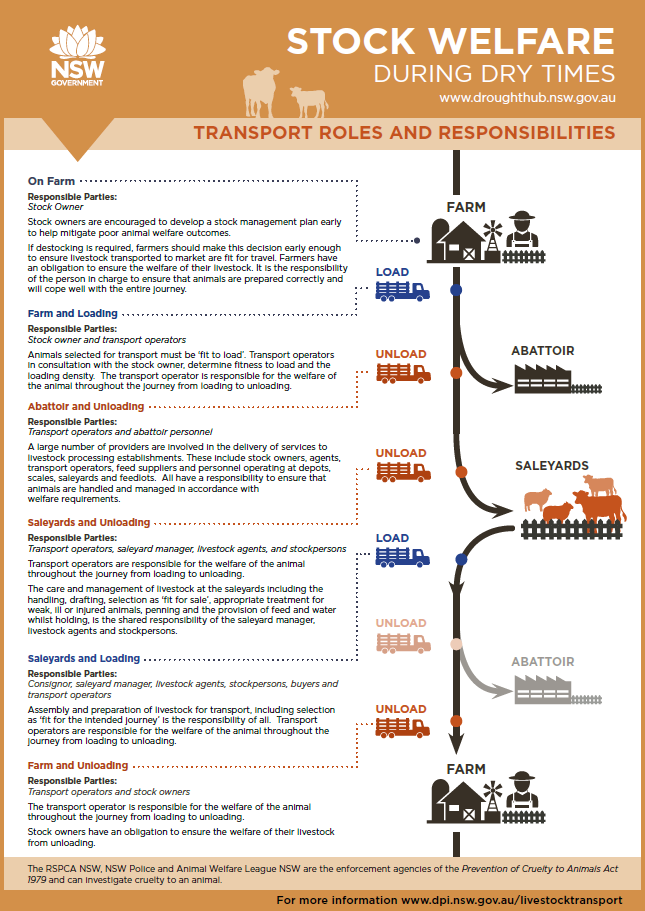
Animal welfare during dry times
Animal welfare considerations are critical when managing stock during dry times, when feed and water resources are in short supply.
Helping stock owners
With much of the state in drought, stock owners across NSW need to make decisions to effectively manage their stock.
Your livestock and other farm animals are your responsibility and it is up to you to plan and prepare for their welfare. By being proactive and making decisions early, you will help ensure good animal welfare outcomes and compliance with the Prevention of Cruelty to Animals Act 1979.
Assess

Understand your circumstances and the options available to you. Seek help and consider expert advice on seasonal conditions, feed, fodder and stock market prices.
Act early

Early intervention ensures good animal welfare outcomes.
- Prepare a stock management plan to outline arrangements and support early intervention.
- Develop plans around destocking, stock movement and transport where required. Contact your Local Land Services for more information.
- Review feeding and fodder strategies. Contact your Local Land Services for more information.
- Develop pasture grazing plans. Implement sacrifice paddocks to protect new pastures and ground cover across the property.
- Implement business planning and strategic thinking in consultation with your bank, accountant or financial planner. Refer to Droughthub for more information.
Be aware

Legal obligations
You have a legal and moral obligation to get it right. Penalties can apply for people who do not provide for the welfare of their animals.
Your stock can also be seized and disposed of in certain circumstances, as detailed in the Prevention
of Cruelty to Animals Act 1979.
Do the right thing and make sure you are assessing and acting early.
Seek help

Help is available to ensure you get the right advice. Visit DroughtHub for information on:
- Planning, managing and recovering from drought
- Business support
- Financial assistance
- Wellbeing support
Transport roles and responsibilities
Managing the animal welfare risk factors is a shared responsibility between all people involved in the transportation process, including stock owners, transport operators, saleyard personnel, livestock agents and stockpersons.

Guidelines and standards
- Welfare scoring nutritionally deprived beef cattle, dairy cattle and their crosses, sheep and horses
- Cattle Standards & Guidelines (PDF, 1.25 MB)
- Sheep Standards and Guidelines (PDF, 1.16 MB)
- Model Code of Practice for the Welfare of Animals: The Goat
(revised National Goat Standards and Guidelines have been developed but not yet implemented in NSW. Should be used as a reference guide as they are not prescribed)
- Model Code of Practice for the Welfare of Animals: Animals at Saleyards
(revised national Standards and Guidelines have been developed by not yet implemented in NSW)
Inspections and enforcement
The enforcement agencies of the Prevention of Cruelty to Animals Act 1979 (POCTA Act) can investigate cruelty to an animal. The enforcement agencies are:
Read more about inspections and enforcement activities.
Key resources
The NSW DPI Animal Welfare web page has information on animal welfare including links to relevant legislation and mandatory standards.
The Land Transport of Livestock webpage provides links to key documents such as MLA’s ‘Is it fit to load’ and DPI’s ‘Welfare scoring livestock’ guides.
Local Land Services (LLS) can provide advice on drought management including animal health, nutrition and pasture management. Call 1300 795 299 or visit your nearest LLS office.
Rural Adversity Mental Health Program (RAMHP) is a state-wide program that links rural people to the help they need. Visit the website or call the NSW Mental Health Line on 1800 011 511.
Australian Animal Welfare Standards and Guidelines.
Primary producers are encouraged to visit DroughtHub for the latest State Seasonal Updates and information on a range of support services to prepare for and manage drought conditions.
The NSW DPI publication Welfare scoring nutritionally deprived beef cattle, dairy cattle and their crosses, sheep and horses is a useful guide to assessing animal condition. This guide is also referenced in the Regulation.
Managing drought is a handbook that has been prepared to assist primary producers in making financial and management decisions which will see them through extended dry periods.
Drought Feed Calculator App. Designed for use in the paddock to develop well-informed and cost efficient feed strategies for sheep and cattle. Search “Drought Feed Calculator”

